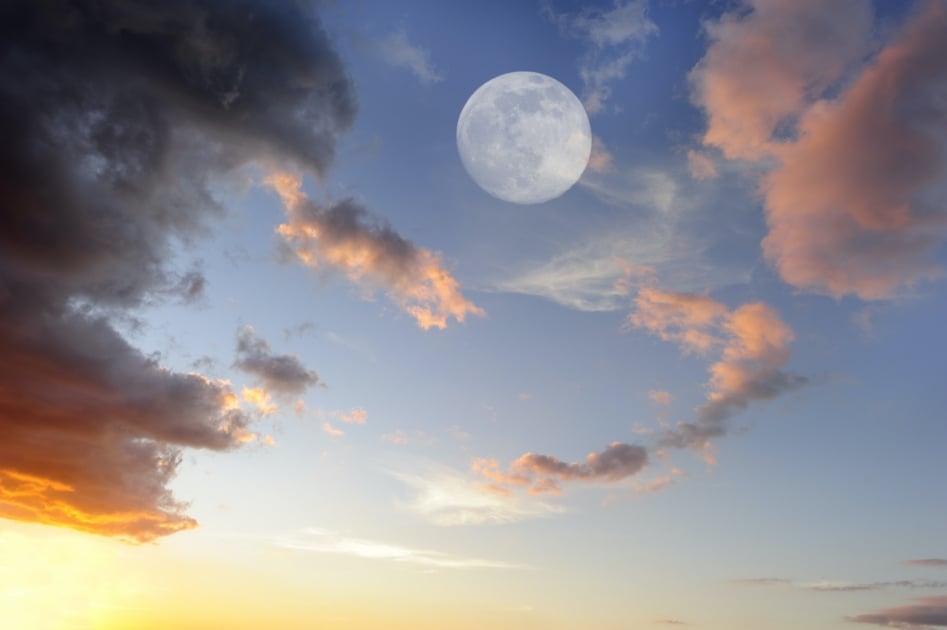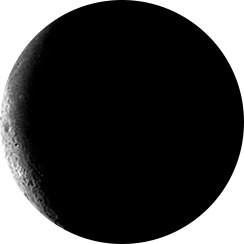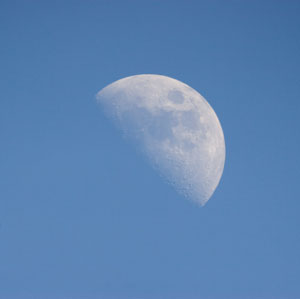Why Can You See the Moon During the Day?

A full Moon at night is impossible to ignore, but have you ever seen our natural satellite during the day? Most people don’t realize it, but the sight of a daytime Moon in a blue sky is just as common as seeing one in a dark sky at night.
How can that be? After all, the Moon isn’t a light source in itself. All it does is reflect sunlight, and even if it’s brightest it’s a whopping 40,000 times less brighter than the Sun. However, if you consider how the Moon orbits the Earth and where it is positioned in relation to the Sun, it quickly becomes apparent that it is in the daytime sky very often.
Here’s everything you need to know about why the Moon is visible in the daytime and where and when to see it with unaided eyes.
RELATED: When Is The Next Full Moon?
Full And New Moons
Most of us only notice the Moon when it is as bright as it gets and in the night sky for the longest—during its “full” phase. There is typically one full Moon each month. That’s because it orbits the Earth once every 29.5 days. Exactly half of the Moon is always lit by the Sun, just as Earth is. However, only when it’s on the night side of Earth—with Earth in between it and the Sun—does it appear to have its entire face illuminated. That’s a full Moon, at which point the Moon rises in the east close to sunset, shines all night and sets in the west around sunrise. During the day a full Moon is located below the horizon.
The opposite is the case with a New Moon, which occurs two weeks before and after each full Moon. When a Moon is “new” it is between the Earth and the Sun, so very close to the Sun during the day and lost in its glare.
The phases of the Moon—what we see from Earth—change as it orbits Earth because it changes its position with respect to the Sun.

Waning Crescent
13% of Full
RELATED: Lunar Phases Explained
How The Moon Moves
The Moon always appears to rise in the east and set in the west, just as stars do, because Earth is rotating from west to east. However, the Moon also orbits from west to east. Since it takes 29.5 days to orbit yet there are only 24 hours in a day on Earth, the Moon rises about 50 minutes later each day. It makes sense that if the Moon rises later in the east it will set later in the west. So if it rises a few hours after sunset it will set a few hours after sunrise, so will be in the daytime sky. But can we see it? Yes—sometimes very easily.
Best Time To See The Moon In The Afternoon
Just after an invisible New Moon it is possible to see a very slim crescent in the western sky in the early evening. This waxing crescent rises around 50 minutes earlier each evening, eventually becoming a First Quarter–when it is 50% illuminated from our point of view. This is the opening of the window for seeing a bright daytime Moon.

A First Quarter Moon rises in the east about midday when it is fifty percent lit. Over the next seven nights, it rises about 50 minutes later and is slightly brighter each night as it approaches its full phase. During this period all you have to do is look to the east in the afternoon and you will see a big, bright Moon. In the few days before the full phase, a beautiful, bright daytime Moon is easy to see relatively low above the eastern horizon in the late afternoon.
Best Time To See The Moon In The Morning
The opposite happens in the week after a full Moon as it wanes to a Last Quarter phase. The Moon rises later and later at night, consequently being visible later and later in the morning sky. During this period a big and bright Moon may be seen sinking towards the western horizon during the morning.
Rise And Set Times According To Lunar Phases
- New Moon: Rises at sunrise, sets at sunset.
- Waxing Crescent: Visible just after sunset.
- First Quarter: Rises at noon, sets at midnight.
- Waxing Gibbous: Rises before sunset, sets before sunrise.
- Full: Rises at sunset, sets at sunrise.
- Waning Gibbous: Rises after sunset, sets after sunrise.
- Last Quarter: Rises at midnight, sets at noon.
- Waning Crescent: Visible just before sunrise.
See exact moonrise/moonset times on your Member Dashboard. Not a Member yet? Sign-up now.
When To See Planets In The Daytime
It’s also possible to see some of the planets during the day. The inner planets—Venus and Mercury—are, from our point of view, always relatively close to the Sun. That means they can occasionally be seen in twilight just after sunset or just before sunrise.
Mercury is hard to spot because it’s small and dim, but Venus is larger, often very close to Earth, and has global cloud cover that reflects a lot of sunlight. It’s the third-brightest object in the night sky and can often be seen during twilight just after sunset or just before sunrise.
It’s also possible to see Jupiter and Mars when they are at their brightest, also just after sunset or just before sunrise. The time to look is just before they reach their brightest. That happens when they are opposite the Sun with respect to Earth (just like a full Moon). For a few weeks before what astronomers called their opposition, Jupiter and Mars can be seen shining brightly in the east in twilight.
Planets During A Total Solar Eclipse
By far the easiest time to see planets during the day is during a total solar eclipse, which presently occurs about 13 times in every 18 years. Although it’s not possible to see the New Moon during an eclipse its silhouette against the Sun’s disk is obvious. An eclipse of the Sun by the Moon turns the daytime sky into twilight. If there are bright planets nearby—the brightest being Venus and Jupiter—then they are easy to spot during (and even before) the few minutes of totality when all of the Sun’s light is blocked.
Venus and Jupiter will make an appearance just 15 degrees and 30 degrees from the Sun, respectively, during the next total solar eclipse, which will occur across Mexico, the US and Canada on Monday, April 8, 2024. To experience totality and see Venus it’s imperative to be inside the 105-120 miles wide path of totality.
Join The Discussion
When was the last time you saw the Moon during the day?
Share your experience (and photos!) with your community here in the comments!







